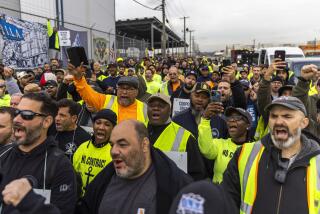Help for Ports Won’t Come Via Canal
The Panama Canal, seen by some as an alternative artery to get around the clogged ports of Los Angeles and Long Beach, appears to be in need of a bypass procedure itself.
With record amounts of cargo being brought through the Los Angeles-Long Beach port complex -- leading to long delays -- the historic, 90-year-old canal has been hailed by some as another way for shippers to transport goods from Asia to the East Coast.
But Monday the Panama Canal Authority noted that the waterway is already “moving more cargo ... than ever before” and “nearing maximum capacity levels.”
The authority issued its statement to tout the canal’s growing role in international trade and to underscore the importance of a planned expansion there.
Yet to those looking for some immediate relief at the Southern California ports, the message had an entirely different meaning: The canal, which carries ships from the Pacific Ocean to the Atlantic Ocean through the Isthmus of Panama, lacks the capacity to make a big difference anytime soon.
The types of infrastructure projects necessary to accommodate significantly more cargo traffic “tend to happen over multiple years rather than a few months,” said Anne Van Praagh, an analyst with Moody’s Investors Service. “That kind of commitment doesn’t happen quickly.”
Retailers and logistics experts had expressed hope in recent months that the Panama Canal might represent a ready solution to ease at least some of the gridlock plaguing cargo facilities in Los Angeles and Long Beach, which distribute goods for cross-country travel via truck and rail.
A consultant speaking at a June logistics symposium in Oakland, for example, predicted that the Southern California ports would soon lose lots of business to the canal, a 51-mile system of chambers and locks.
But, in fact, the Panama Canal may already have absorbed about all of the Asian shipping traffic that it can -- at least for now.
Those running the canal are making “every effort to increase capacity to match demand,” authority administrator Alberto Aleman Zubieta said. The situation presents “great opportunities and challenges.”
There are other problems too. Even if many more cargo ships could transit the canal, East Coast ports aren’t prepared to handle them.
As in Panama, there are several expansion plans afoot at the Eastern ports. But to serve the biggest cargo ships, harbors must be dredged, bigger terminals must be built, space for new container yards must be found, and railroad connections must be improved.
Once again, these upgrades will take many years to complete.
“The East Coast ports will increase their share” of Asian trade, Van Praagh said, “but that will take a major investment” -- as much as $3.8 billion.
For their part, the twin ports of Los Angeles and Long Beach are now predicting a record 13 million containers to come through this year. That would shatter the record of 11.9 million set last year. Together, the port complex is the third-busiest in the world, trailing only Hong Kong and Singapore.
To try to cope with the flood of cargo, the shipping lines and the International Longshore and Warehouse Union recently agreed on technological improvements and a major expansion in the number of dockworkers at the two harbors. Extended hours at the terminal gates and improved railroad service also promise to help -- but perhaps not as much as some would expect.
Even with those steps, “it will be difficult to continue adding volume,” said Don Snyder, marketing manager of the Port of Long Beach.
That’s one reason the Panama Canal plans to invest as much as $8 billion over the next several years, in part to make two major improvements: dredging Gatun Lake in the western part of the canal and digging through the rock and shale of the Continental Divide to widen the Gaillard Cut. That is the narrowest point in the canal.
Because the waterway isn’t wide enough for the largest types of cargo ships -- known as post-Panamax and super post-Panamax -- the authority’s blueprint also calls for a third set of locks that would allow such behemoths to pass.
More to Read
Sign up for Essential California
The most important California stories and recommendations in your inbox every morning.
You may occasionally receive promotional content from the Los Angeles Times.











